Belfast is a rare case in terms of tourism. Most of its tourism industry revolves around the two “Big Ts”, that is “the Troubles” (more on that separately later) and the legacy of the RMS Titanic, both catered for by a range of specific individual tourist attractions and activities. It’s not very often that a city’s top tourist attractions all fall within the catchment area of dark tourism. But both Troubles tourism and Titanic tourism do firmly do so. I can’t think of many other places where dark tourism is as dominant a part of the local tourism portfolio … Berlin of course (as the capital of “dark tourism”), also Hiroshima and (to a lesser degree) Nagasaki as well as Phnom Penh, perhaps, maybe also Krakow or Gdansk. But these are all exceptional cases. Otherwise, more usually, dark tourism is a rather niche cousin to mainstream tourism. Not so in Belfast, where it is right in your face. But that’s a comparatively recent development.
In the case of Troubles tourism, this only really took off after the Good Friday Agreement of 1998 put an official “end” to the conflict (though it’s still simmering quite a bit under the lid!) and Belfast began generally opening up to tourism, after decades of having “enjoyed” a reputation of something like a “no-go zone”.
With regard to Titanic tourism, the development took even longer. For the first almost one hundred years after the sinking of the Titanic, this was rather seen as an embarrassment to Belfast and its otherwise proud shipbuilding legacy, at least locally. So the topic was rather hushed up. This didn’t begin to change until the 1997 blockbuster movie “Titanic” by James Cameron rekindled interest worldwide in what really must be the most legendary shipwreck story of all times.
As the centenary of the sinking in 2012 draw closer, Belfast somehow overcame its reservations regarding the topic and started to embrace the legacy – realizing also that, short of the wreck itself, nowhere in the world would be better poised to cover this legacy in terms of tourism. (Although other places associated with the Titanic include Cherbourg, France, Southampton, Great Britain, and Halifax, Canada – plus there are numerous geographically unrelated places featuring large-scale Titanic-themed visitor attractions, especially in the USA).
And so the first Titanic-themed guided tours appeared (in particular the “Titanic Tours” such as I was on in 2012, which unfortunately don’t seem to be available any longer), and sites associated with the ship started to be commodified for tourism. The biggest such development is the “Titanic Quarter” at the former Harland & Wolff shipyard where Titanic and her sister ships where designed, built, launched and outfitted.
The centrepiece of it all opened in April 2012, just in time for the centenary of the ship’s maiden voyage and subsequent sinking: the “Titanic Belfast Experience,” a shiny, hi-tech, multimedia, immersive “museum” of sorts (but there’s a reason they prefer to refer to it as an “experience”). Here’s a photo of the spectacular exterior – whose four corners are reminiscent of huge ship’s bows:

The exhibition inside is hi-tech, state-of-the-art and indeed very “immersive” (hence the expression “experience”). One such element is a “shipyard ride”, where visitors board little remote-controlled carriages that then travel through a huge 3-D mock-up of a shipyard full of colourful light displays, as indicated in this photo:

In the main exhibition part about the Titanic, there are various media-heavy mock-ups, such as this one of a first-class passenger cabin with two actors on screen playing such passengers, as seen in this photo:

The final part of the exhibition received a complete overhaul early this year, and it had just reopened in time for my visit in April. My previous, general Northern-Ireland blog post already had a photo from that part with its brand-new large-scale video projections, so I won’t repeat that here. Just one more new one:
Right at the end of the exhibition there is this new element:
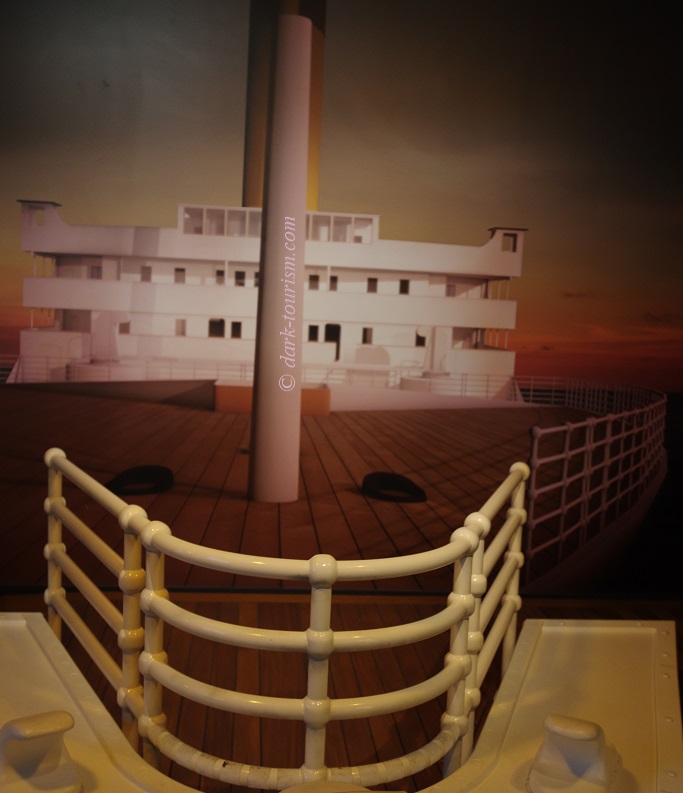
This is clearly a “reconstruction” of the railings at the bow of the ship that featured so iconically in the 1997 movie “Titanic” in that famous scene with lead stars Kate Winslet and Leonardo DiCaprio. At this mock-up it doesn’t take much invitation for visitors to re-enact that scene with their arms spread wide while someone takes a photo, or they take a selfie themselves. In fact I had to wait quite a long time before being able to quickly take this photo in a rare short moment without any people in the frame, such was the rush for this selfie-posing. Practically every visitor (except my wife and myself) wanted to take that same photo, which seemed as if it was as good as obligatory (or is it just the herd pull?).
Also part of the Titanic Belfast franchise is the restored tender SS Nomadic, which ferried passengers from the port of Cherbourg to the Titanic on her ill-fated maiden voyage:

The Nomadic carried on as a White Star Line tender for a number of years before being decommissioned and put to other uses (e.g. military ones in both World Wars). In its last commercial role it functioned as a floating restaurant on the River Seine in Paris. From there it was transported to Northern Ireland, subsequently saved from the scrapyard and painstakingly restored to its former look as a tender for the Titanic. It is in fact the last surviving vessel that served in the White Star Line. The period interiors now house another exhibition.
Just north of the Titanic Belfast Experience building are the original former slipways, where both Titanic and her sister ships Olympic and Britannic were built and launched from. The outlines of the ships are now marked in the ground by lines that after dark are lit up in blue, as seen in this photo:
.

.
Also still part of the Titanic Quarter, at its northernmost end is the original Thompson graving dock – at the time of the Titanic it was the largest of its kind in the world. It was here that Titanic and her sister ships were outfitted after their launch. So this was where the engines, funnels, propellers and all the sumptuous interiors were added:
.

.
When I was first there in 2012 I was able to use those stairs at the far end to get down to the bottom of the dock. But on my return visit last April access to the dock and the associated pump house was not possible. That was because of some building work still going on at the former pump house – which now houses the Titanic whiskey distillery. You can just about spot the three copper stills inside (in the bottom right corner) in this photo:
.

.
The biggest change between my first visit to Belfast in 2012 and my recent return visit in April this year was the newly developed Titanic Hotel, housed in the restored and converted former headquarters of the Harland & Wolff shipyard, where Titanic was designed and built. Here’s a view of the front, right opposite the Titanic Belfast:
.

.
Apart from serving as a regular hotel, albeit with a strong maritime emphasis in the interior design, as well as featuring bars and a classy restaurant, parts of the restored building are a bit like a museum. For example this large lounge room furnished in period style:
.

.
From this room on the first floor you can peek through the windows on the left for a good view into what used to be one of the two lofty drawing offices (where the ships’ designs were put on paper), which now serves as the hotel’s grand bar:
.

.
In this photo you can just about make out the scale model of the Titanic at the far end. Here’s a photo taken from closer up:
.
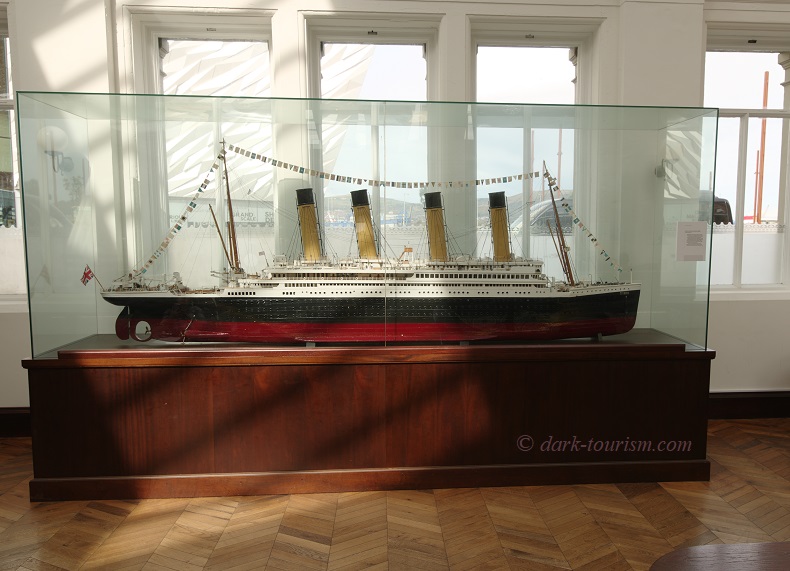
.
By the way, lovingly made as this model at first glance seems to be, I noticed a few inaccuracies – for instance the fact that the central one of the three propellers at the stern has three-blades in this model, just like the other two outer propellers, when in reality the central propeller was four-bladed (as can clearly be seen in the various period photos on display in the hotel and the exhibitions).
But so much for the Titanic Quarter and all its recent developments.
The only non-recent acknowledgement of the Titanic and its maritime disaster of 1912 is the rather traditional and bland-looking official memorial monument, erected not long after the sinking, located to the side of Belfast City Hall:
.
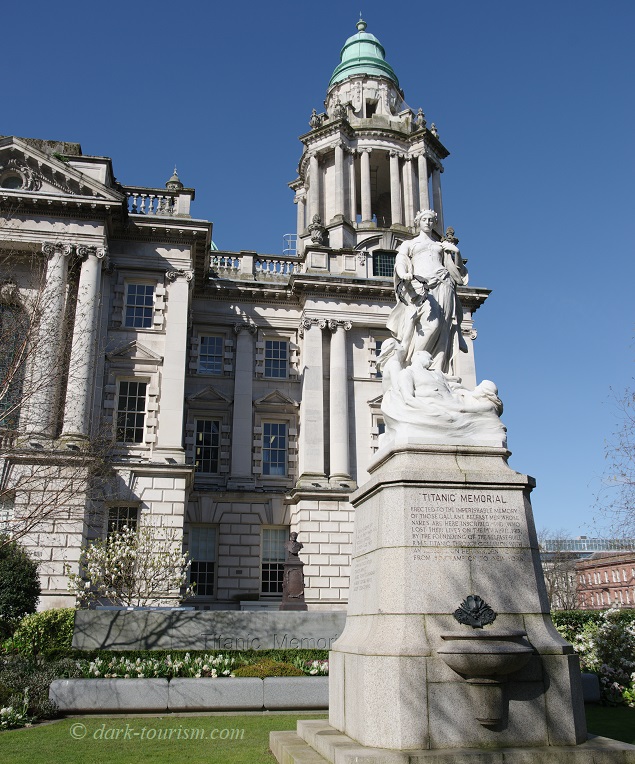
.
Inside the City Hall you can spot another Titanic reference in one of the several grand stained-glass windows. This one features some shipbuilding-related images, including the iconic Sampson and Goliath cranes of the Harland & Wolff shipyard (still key landmarks of Belfast today) as well as a little Titanic herself, ploughing through the waves …:
.
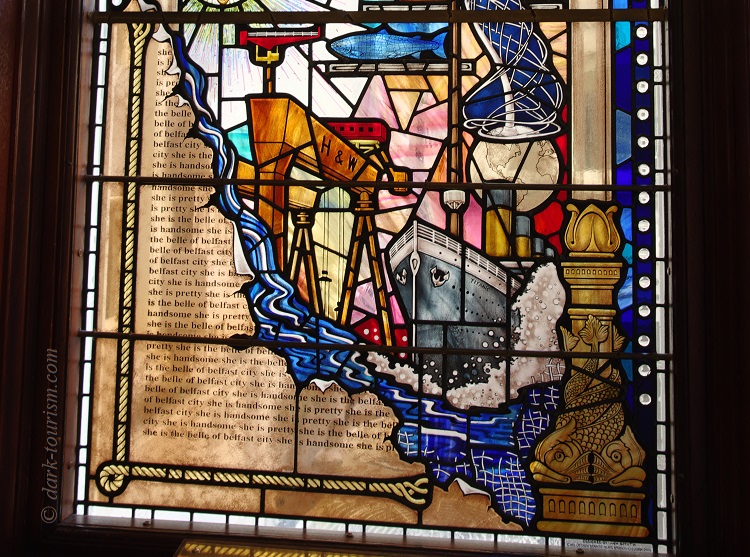
.
A rather unexpected place to find Titanic memorabilia is in the ground-floor main bar of the large Robinsons pub opposite the Europa Hotel (see this previous blog post). On display are, amongst other things, these pieces of White Star Line crockery:
.

.
The display of a life jacket even comes with a certificate of authenticity:
.
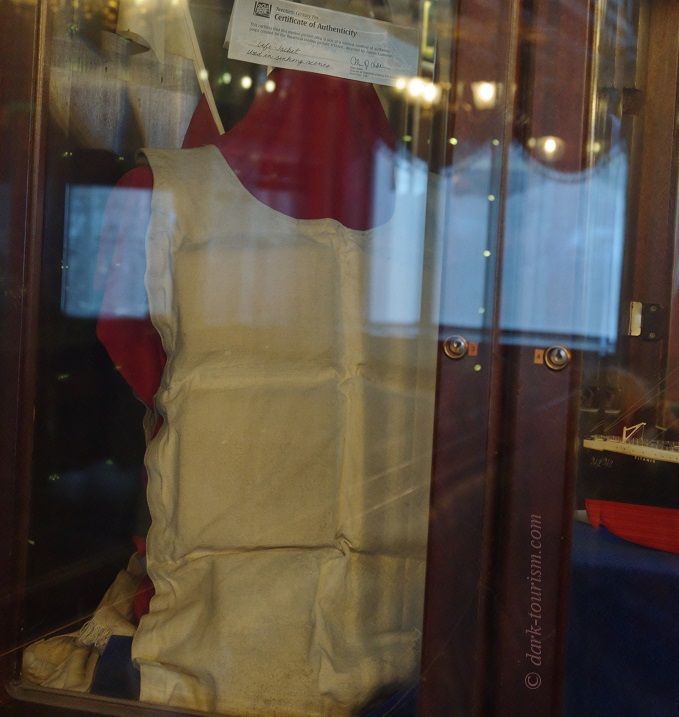
.
There’s yet another full-blown museum exhibition about the Titanic, also featuring various original artefacts, including several salvaged from the actual wreck in the 1990s. This exhibition is part of the Ulster Transport Museum on the north-eastern edge of Belfast. Again, there are several pieces of White Star Line crockery as well as tickets and various other items on display.
.

.
Also part of the exhibition is this striking scale model of the ship as it was dipping forward shortly before going under:
..

.
On my walking excursion into East Belfast I also spotted some Titanic-related wall murals, the very grandest of which has to be this one:
.
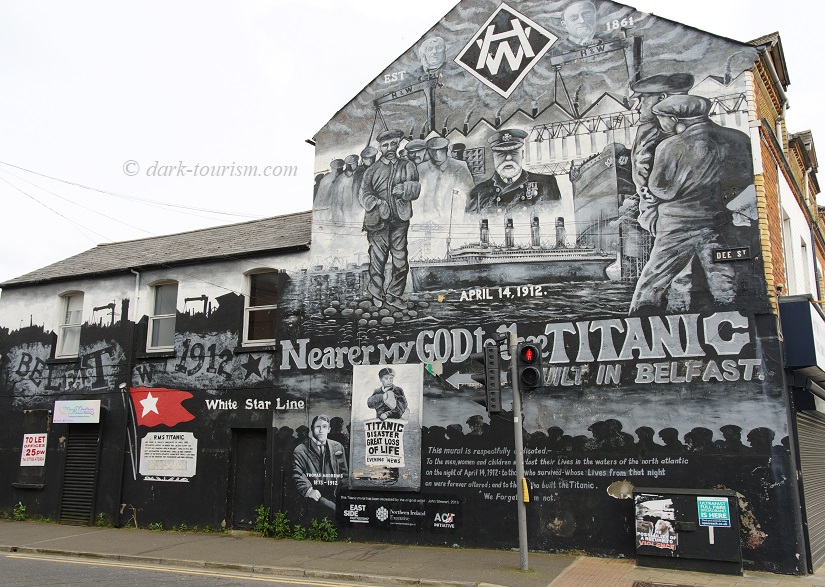
.
Also to be found in East Belfast is this exceptionally celebratory Titanic mural:
.
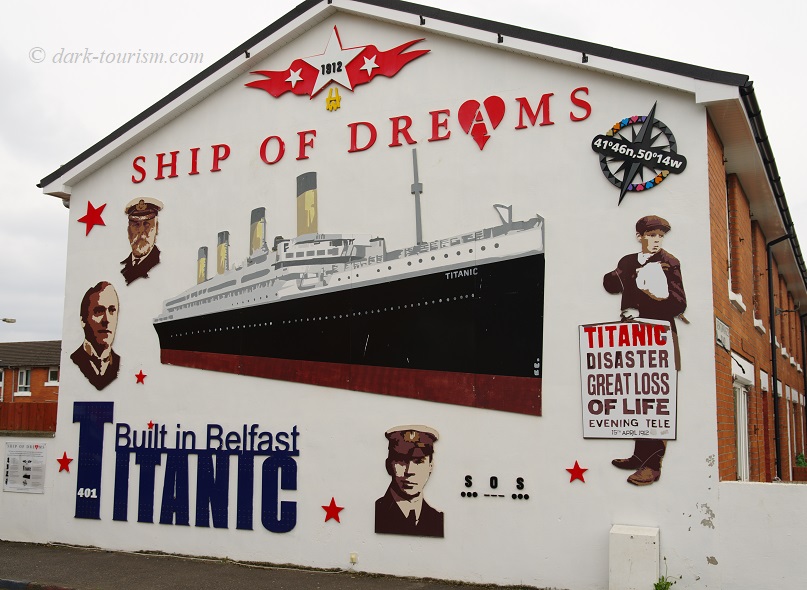
.
As elaborated on in the first few paragraphs of this post (see above), you would not have seen such celebratory expressions of the Titanic legacy until fairly recently (about a good decade ago).
Not everybody seems to have followed that change of attitude, however, as I found expressed in this graffito addition to yet another Titanic image in East Belfast (same image as the featured photo at the top of this post):
.

.
While this graffito shows that some resentment towards the Titanic heritage still exists in Belfast, there’s still no denying that the city’s tourism industry has fully embraced it. At least half a dozen visitor attractions catering to the Titanic legend in Belfast alone spell it out clearly. It really has become one of two dominating thematic strands in Belfast tourism – the other being, of course, “the Troubles” … but that’s for another thematic post.
For now this is it.
.
.
.
.




